
A blueprint is a duplicate of a technical schematic that uses a contact print process, which is done on light-sensitive sheets of paper. It was first introduced by Sir John Herschel in 1842, and it allowed people to make an endless amount of copies at a rapid rate. It has been used to reproduce technical specification drawings, which are commonly used in construction and other industry-related fields. The process of making a blueprint drawing is characterized by a series of white lines that are printed on a blue background, which is a negative of the original drawing. However, the process is not able to reproduce colors or shades of gray. Due to the rise of modern technology, this process is now obsolete. But the term is often used to refer to any type of floor plan or technical drawing.

Features of the Blueprint Process
The blueprint process uses a photosensitive ferric compound, which allows the image to be printed on a piece of paper. It is then dried and developed by using a solution that gives it a distinctive blue color. It’s a relatively simple process, and it has several features that made it useful. Some of them included:
- The ability to create a stable image.
- It’s a contact process that doesn’t require a large-field optical system.
- The document being reproduced will have the same scale as the original.
- The dark blue background makes it more difficult to alter.
The process of creating a blueprint drawing eliminated the need for photolithographic production, which was more expensive. And it also eliminated the need for hand-tracing original documents, which wasn’t as accurate. In fact, the blueprint process was one-tenth the cost of other reproduction methods. Paper was a common choice for blueprinting, but linen was also used if they needed something more durable. However, it tended to shrink slightly over time, so they started to use imitation vellum and polyester film (called Mylar) instead.

How Blueprints Are Used in the Digital Age
Aside from the invention of xerography (which is the technology used in copy machines), a
blueprint can be created through the use of Computer-Aided Design. And this document can be viewed on any display. This can include a smartphone or any other mobile device, and there’s software that will allow them to annotate electronic drawings. However, many older blueprints have been archived and are still in use. This is because, in many cases, the conversion to a digital format is too expensive. Most of the roads and buildings that were built before 1990 will not have digital blueprints, and these drawings are necessary for repairing and modifying these structures. Because of this, there is still a need for
blueprint storage and other filing systems.
If you need as solid
blueprint storage solution, feel free to visit Engineering Supply. We have a line of products from quality manufacturers, and all of them have been built to last. Be sure to look at what we have in stock, so you can find a place to put any
blueprint drawing or large document.